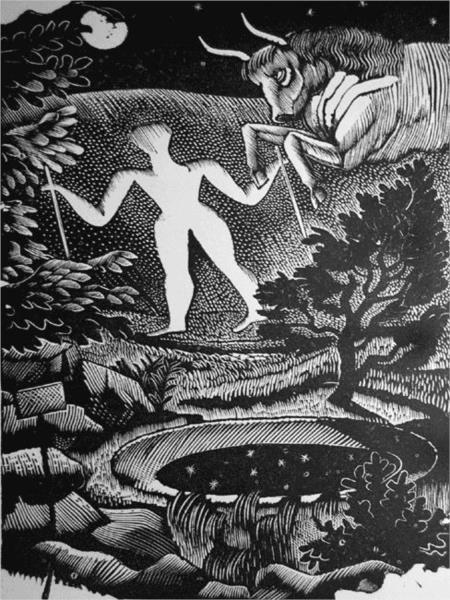Description
Eric Ravilus is one of the most prominent British artists of the twentieth century, known for its ability to capture the essence of the English landscape with modern sensitivity. The work "May - Xilography of Wilmington's long man - 1925" is a clear example of his talent to merge a traditional technique such as xylography with a contemporary and insightful approach.
The work itself portrays "The long man of Wilmington", an enigmatic figure carved in the Windover Hill hill in East Sussex. This anthropomorphic figure, which possibly dates back to the Iron Age or the medieval period, is an icon of the British landscape. Ravilus, with its accuracy and lyrical style, captures not only the figure itself, but also the atmosphere and the surrounding environment.
The composition of the xylography is remarkably balanced. The figure of the long man occupies the center, with his arms extended, holding two rods. This provision creates a symmetry that is both disturbing and serene. Ravilious's choice to focus on this historical figure reflects a fascination for the past and his permanence in the present, a recurring theme in his work.
The use of black and white in this xylography underlines the simplicity and purity of the figure. The intricate details of the environment Fine lines that represent the texture of the soil and the wavy hills in the background show the technical mastery of Ravilus. Despite the chromatic limitation, the piece is full of life and energy, managing to convey a sensation of temporality and timelessness at the same time.
Ravilous does not conform to simply replicate the figure of the long man; Instead, it infuses the work with its own distinctive style. The economy of lines and geometric clarity are characteristics that define much of their work. In this xylography, these elements allow the form of the long man to resonate with an almost mystical force.
The historical context is also crucial when appreciating this work. Made in 1925, in a time of social and technological change, Ravilous's xylography can be interpreted as a comment on the resistance of the past against modernity. The figure of the long man, an ancient and inscrutable presence, is still standing, immutable, while the world around it is transformed.
In Ravilus' work, a connection with other contemporary artists who explored the British landscape is also perceived. His colleagues and friends, such as Edward Bawden and John Nash, shared their interest in capturing the essence of the rural environment with a graphic and modernist approach. However, the unique capacity of Ravilious to combine a detailed landscape appreciation with an innovative technique distinguishes even within this circle.
"May - Xilography of Wilmington's long man - 1925" It is not only a masterful representation of an icon of the British landscape, but also a testament of Eric Ravilious's ability to merge tradition with modernity. This work continues to fascinate and evoke reflections on the relationship between the past and the present, nature and humanity, in an eternal dance drawn in lines and shadows.
Ravilus' work, including this xylography, continues to inspire new generations of artists and art lovers, and reaffirms their legacy as one of the great innovatives of graphic art of the twentieth century.
KUADROS ©, a famous paint on your wall.
Hand-made oil painting reproductions, with the quality of professional artists and the distinctive seal of KUADROS ©.
Art reproduction service with satisfaction guarantee. If you are not completely satisfied with the replica of your painting, we refund your money 100%.

